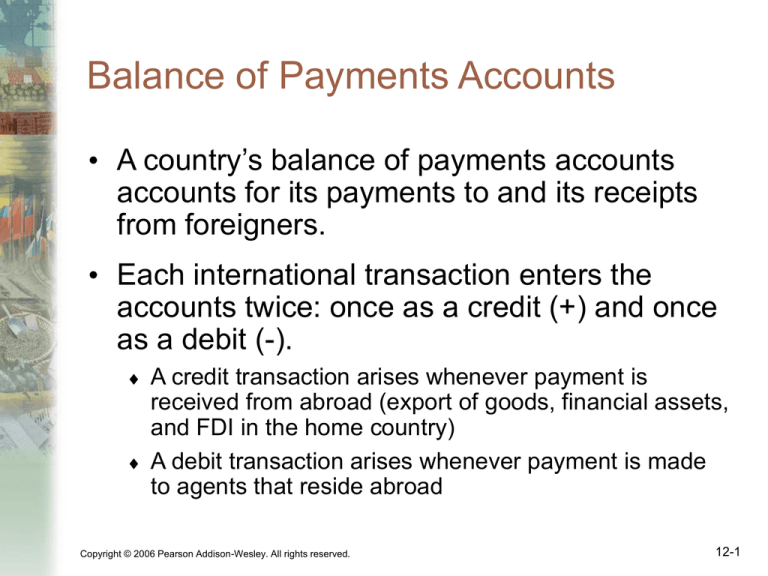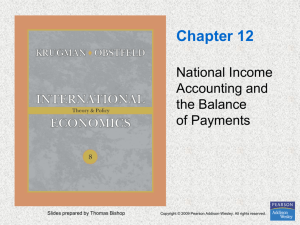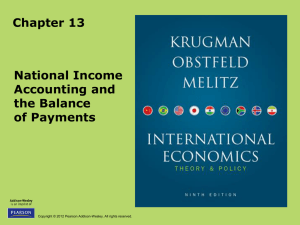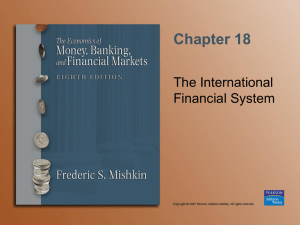
Balance of Payments Accounts
• A country’s balance of payments accounts
accounts for its payments to and its receipts
from foreigners.
• Each international transaction enters the
accounts twice: once as a credit (+) and once
as a debit (-).
A credit transaction arises whenever payment is
received from abroad (export of goods, financial assets,
and FDI in the home country)
A debit transaction arises whenever payment is made
to agents that reside abroad
Copyright © 2006 Pearson Addison-Wesley. All rights reserved.
12-1
Balance of Payments Accounts (cont.)
• The balance of payment accounts are
separated into 3 broad accounts:
current account: accounts for flows of goods and
services (imports and exports).
financial account: accounts for flows of financial
assets (financial capital).
capital account: flows of special categories of
assets (capital), typically non-market, nonproduced, or intangible assets like debt
forgiveness, copyrights and trademarks.
Copyright © 2006 Pearson Addison-Wesley. All rights reserved.
12-2
Example of Balance of
Payment Accounting
• You import a DVD of Japanese anime by using your
debit card.
• The Japanese producer of anime deposits the funds
in its bank account in San Francisco. The bank
credits the account by the amount of the deposit.
DVD purchase
–$30
(current account)
Credit (“sale”) of bank account by bank
+$30
(financial account)
Copyright © 2006 Pearson Addison-Wesley. All rights reserved.
12-3
Example of Balance of
Payment Accounting (cont.)
• You invest in the Japanese stock market by buying
$500 in Sony stock.
• Sony deposits your funds in its Los Angeles bank
account. The bank credits the account by the amount
of the deposit.
Purchase of stock
–$500
(financial account)
Credit (“sale”) of bank account by bank
+$500
(financial account)
Copyright © 2006 Pearson Addison-Wesley. All rights reserved.
12-4
Example of Balance of
Payment Accounting (cont.)
• US banks forgive a $100 M debt owed by the
government of Argentina through debt restructuring.
• US banks who hold the debt thereby reduce the debt
by crediting Argentina's bank accounts.
Debt forgiveness: non-market transfer
–$100 M
(capital account)
Credit (“sale”) of bank account by bank
+$100 M
(financial account)
Copyright © 2006 Pearson Addison-Wesley. All rights reserved.
12-5
Example of Balance of
Payment Accounting (cont.)
• An American buys a share of German stock, paying
by writing a check on an account with a Swiss bank.
• A tourist from Dallas buys a meal at a restaurant in
Paris, France, paying with a traveler’s check.
• A U.S.-owned factory in U.K. uses local earnings to
buy additional machinery.
Copyright © 2006 Pearson Addison-Wesley. All rights reserved.
12-6
How Do the Balance of Payments
Accounts Balance?
• Due to the double entry of each transaction,
the balance of payments accounts will
balance by the following equation:
current account +
financial account +
capital account = 0
Copyright © 2006 Pearson Addison-Wesley. All rights reserved.
12-7
US Balance of Payments Accounts, 2003
in Billions of Dollars
Copyright © 2006 Pearson Addison-Wesley. All rights reserved.
12-8
US Balance of Payments Accounts, 2003
in Billions of Dollars (cont.)
Copyright © 2006 Pearson Addison-Wesley. All rights reserved.
12-9
Balance of Payments Accounts
•
•
Each of the 3 broad accounts are more finely
divided:
Current account: imports and exports
1.
2.
3.
•
merchandise (goods like DVDs)
services (payments for legal services, shipping
services, tourist meals,…)
income receipts (interest and dividend payments,
earnings of firms and workers operating in foreign
countries)
Current account: net unilateral transfers
gifts (transfers) across countries that do not
purchase a good or service nor serve as income
Copyright © 2006 Pearson Addison-Wesley. All rights reserved.
12-10
Balance of Payments Accounts (cont.)
• Capital account: records special asset
transfers, but this is a minor account for the
US.
Copyright © 2006 Pearson Addison-Wesley. All rights reserved.
12-11
Balance of Payments Accounts (cont.)
• Financial account: the difference between sales of
domestic assets to foreigners and purchases of
foreign assets by domestic citizens.
• Financial (capital) inflow
Foreigners loan to domestic citizens by acquiring domestic
assets.
Foreign owned (sold) assets in the domestic economy are a
credit (+)
• Financial (capital) outflow
Domestic citizens loan to foreigners by acquiring foreign
assets.
Domestically owned (purchased) assets in foreign economies
are a debit (-)
Copyright © 2006 Pearson Addison-Wesley. All rights reserved.
12-12
Balance of Payments Accounts (cont.)
•
Financial account has at least
3 categories:
1.
Official (international) reserve assets
2.
All other assets
3.
Statistical discrepancy
Copyright © 2006 Pearson Addison-Wesley. All rights reserved.
12-13
Balance of Payments Accounts (cont.)
• Official (international) reserve assets:
foreign assets held by central banks to
cushion against instability in international
markets.
Assets include government bonds, currency, gold
and accounts at the International Monetary Fund.
Official reserve assets owned by (sold to) foreign
central banks are a credit (+).
Official reserve assets owned by (purchased by)
the domestic central bank are a debit (-).
Copyright © 2006 Pearson Addison-Wesley. All rights reserved.
12-14
Balance of Payments Accounts (cont.)
• The negative value of the official reserve
assets is called the official settlements
balance or “balance of payments”.
It is the sum of the current account, the capital
account, the non-reserve portion of the financial
account, and the statistical discrepancy.
A negative official settlements balance may
indicate that a country is depleting its official
international reserve assets or may be incurring
debts to foreign central banks.
Copyright © 2006 Pearson Addison-Wesley. All rights reserved.
12-15
Balance of Payments Accounts (cont.)
• Statistical discrepancy
Data from a transaction may come from different
sources that differ in coverage, accuracy, and
timing.
The balance of payments accounts therefore
seldom balance in practice.
The statistical discrepancy is the account added to
or subtracted from the financial account to make it
balance with the current account and capital
account.
Copyright © 2006 Pearson Addison-Wesley. All rights reserved.
12-16
US Balance of Payments Accounts
• The US has the most negative net foreign
wealth in the world, and so is therefore the
world’s largest debtor nation.
• And its current account deficit in 2004 was
$670 billion dollars, so that net foreign wealth
continued to decrease.
• The value of foreign assets held by the
US has grown since 1980, but liabilities of
the US (debt held by foreigners) has grown
more quickly.
Copyright © 2006 Pearson Addison-Wesley. All rights reserved.
12-17
US Balance of Payments Accounts (cont.)
US Balance of Payments Accounts (cont.)
• About 70% of foreign assets held by the US are
denominated in foreign currencies and almost all of
US liabilities (debt) are denominated in dollars.
• Changes in the exchange rate influence value of net
foreign wealth (gross foreign assets minus gross
foreign liabilities).
A depreciation of the US dollar makes foreign assets held by
the US more valuable, but does not change the dollar value
of dollar denominated debt.
Copyright © 2006 Pearson Addison-Wesley. All rights reserved.
12-19






















